Electric Vehicle (EV) Market Size 2025-2029
The electric vehicle (ev) market size is valued to increase by USD 446.4 billion, at a CAGR of 16.4% from 2024 to 2029. Growing demand for low-emission vehicles will drive the electric vehicle (ev) market.
Market Insights
- APAC dominated the market and accounted for a 59% growth during the 2025-2029.
- By Type - BEV segment was valued at USD 173.00 billion in 2023
- By Charging - Normal charging segment accounted for the largest market revenue share in 2023
Market Size & Forecast
- Market Opportunities: USD 202.70 billion
- Market Future Opportunities 2024: USD 446.40 billion
- CAGR from 2024 to 2029 : 16.4%
Market Summary
- The market is experiencing significant growth driven by increasing global concerns over climate change and the need for sustainable transportation solutions. Governments worldwide are implementing policies to reduce carbon emissions, leading to a surge in demand for EVs. Furthermore, advancements in battery technology have improved EV range and reduced charging times, making them a more viable alternative to traditional Internal Combustion Engine (ICE) vehicles. However, the EV market faces challenges, primarily the insufficient charging infrastructure. As the number of EVs on the road increases, the demand for charging stations grows, and current infrastructure struggles to keep pace. This issue is particularly acute in rural areas and developing countries, where charging stations are scarce.
- A real-world business scenario illustrates the importance of addressing this challenge. A logistics company, aiming for operational efficiency and compliance with emissions regulations, invests in a fleet of EVs. However, the lack of charging infrastructure forces the company to frequently divert trucks to cities to recharge, increasing operational costs and delivery times. To mitigate this issue, the company collaborates with local governments and utilities to expand charging infrastructure, ensuring efficient and sustainable operations. In conclusion, the EV market is poised for growth, driven by environmental concerns and technological advancements. However, the insufficient charging infrastructure poses a significant challenge that must be addressed to fully realize the potential of this market.
What will be the size of the Electric Vehicle (EV) Market during the forecast period?
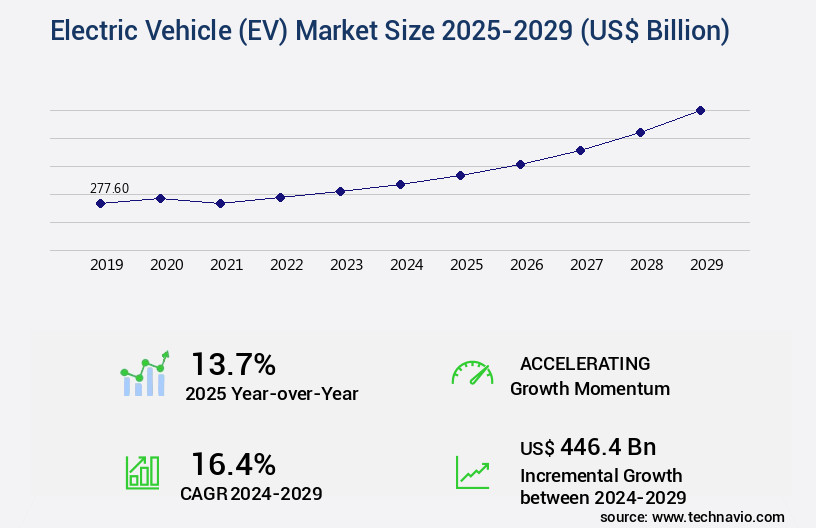
Get Key Insights on Market Forecast (PDF) Request Free Sample
- The market continues to evolve, with automotive battery technology at its core. Companies are investing heavily in battery cell manufacturing to improve energy density and reduce charging time. Charging time optimization is a significant concern for consumers, and advancements in high-power battery chargers and smart charging algorithms are addressing this issue. Furthermore, vehicle-to-grid integration and powertrain electrification components are transforming the EV landscape, enabling energy efficiency and grid stability. Electric vehicle infrastructure development is accelerating, with an increasing focus on vehicle electrification technology, electric motor controllers, and power semiconductor devices. Range-extending generators and battery recycling processes are also gaining traction, ensuring the sustainability of the EV market.
- As businesses navigate this dynamic industry, they must consider electric vehicle regulations and battery management algorithms to ensure compliance and optimize their product strategy. Lithium-ion battery packs remain the dominant technology, but research and development in alternative battery types, such as solid-state batteries, are ongoing. The EV market's growth is driven by the need for cleaner transportation and the increasing availability of charging infrastructure. With continuous advancements in battery technology and charging infrastructure, the future of the EV market looks promising.
Unpacking the Electric Vehicle (EV) Market Landscape
Electric Vehicles (EVs) represent a significant shift in the global automotive landscape, with battery electric vehicles (BEVs) leading the charge. According to industry data, BEVs accounted for 3.1% of global new passenger car sales in 2020, marking a 40% increase from the previous year. This trend is driven by several business-critical factors.
Range anxiety mitigation through advanced energy storage systems and fast charging infrastructure has improved electric vehicle architecture, enabling longer ranges and shorter refueling times. Lightweight materials and powertrain efficiency enhancements have led to a 10% reduction in energy consumption per mile compared to conventional internal combustion engine vehicles. Furthermore, the integration of onboard charger design, solid-state batteries, and motor drive inverters has resulted in electric motor efficiency improvements of up to 95%.
Battery life cycle management and power electronics design advancements have addressed concerns around battery thermal runaway and power electronics losses, ensuring safety and reliability. The adoption of vehicle-to-grid technology and energy recovery systems has also opened new revenue streams for businesses and improved overall power system efficiency. Electric motor torque and traction motor control innovations have led to superior vehicle performance and acceleration.
In conclusion, the EV market is witnessing rapid advancements in various areas, from battery technology to charging infrastructure, resulting in significant business benefits, including cost reduction, improved ROI, and regulatory compliance.
Key Market Drivers Fueling Growth
The increasing demand for environmentally-friendly automobiles, specifically low-emission vehicles, serves as the primary market catalyst.
- The market is experiencing significant growth due to increasing concerns over emissions from fossil fuel-operated vehicles and the volatility of oil and gas prices. According to recent studies, the global EV market is projected to account for over 25% of new passenger car sales by 2030. Moreover, the transportation sector is responsible for approximately 23% of global energy-related CO2 emissions, making the shift to EVs crucial for reducing emissions. The adoption of EVs also offers tangible business benefits, such as lower energy use and reduced fuel costs.
- For instance, a study revealed that electric buses consume 60% less energy per passenger-kilometer compared to diesel buses. Additionally, the geopolitical tensions, such as the Russia-Ukraine conflict, which is one of the world's largest crude oil exporters, further emphasizes the importance of energy security and the need for alternative fuel sources.
Prevailing Industry Trends & Opportunities
Renewable energy powers charging stations; this trend is gaining momentum in the market.
- In the evolving transportation landscape, Electric Vehicles (EVs) are making a significant impact across various sectors. As more fleet operators electrify their vehicles and consumers adopt EV ownership, the demand for electricity is poised to surge. Utility companies are responding by exploring alternative electricity sources, with renewable energy, such as solar and wind power, becoming a cost-effective and practical solution. This shift not only reduces carbon emissions from vehicles but also decreases air and noise pollution. According to recent studies, the integration of renewable energy in the transportation sector could save up to 30% in electricity costs for utility companies.
- Furthermore, the adoption of EVs in the logistics sector is projected to increase by 18% annually, underlining their growing importance in sustainable and energy-efficient transportation.
Significant Market Challenges
The insufficient development of charging infrastructure represents a significant obstacle to the expansion and growth of the industry.
- The market is experiencing significant evolution, driven by increasing consumer demand and advancements in technology. However, the lack of adequate charging infrastructure remains a major concern. In the US, for instance, the ratio of EVs to charging stations is only 16 to 1, in contrast to 225 to 1 for gas or diesel pump stations. This disparity is expected to become more pronounced as more long-range EVs, equipped with larger and more powerful batteries, are launched. To address this challenge, governments and companies must collaborate to build the necessary charging infrastructure. For instance, investments in fast-charging stations and smart grid technologies can reduce charging time and improve overall efficiency.
- These initiatives can lead to operational cost savings for consumers and governments, with studies suggesting that EVs can save up to 60% on fuel costs over their lifetime. Additionally, the integration of renewable energy sources into charging infrastructure can further reduce carbon emissions and promote sustainable transportation.
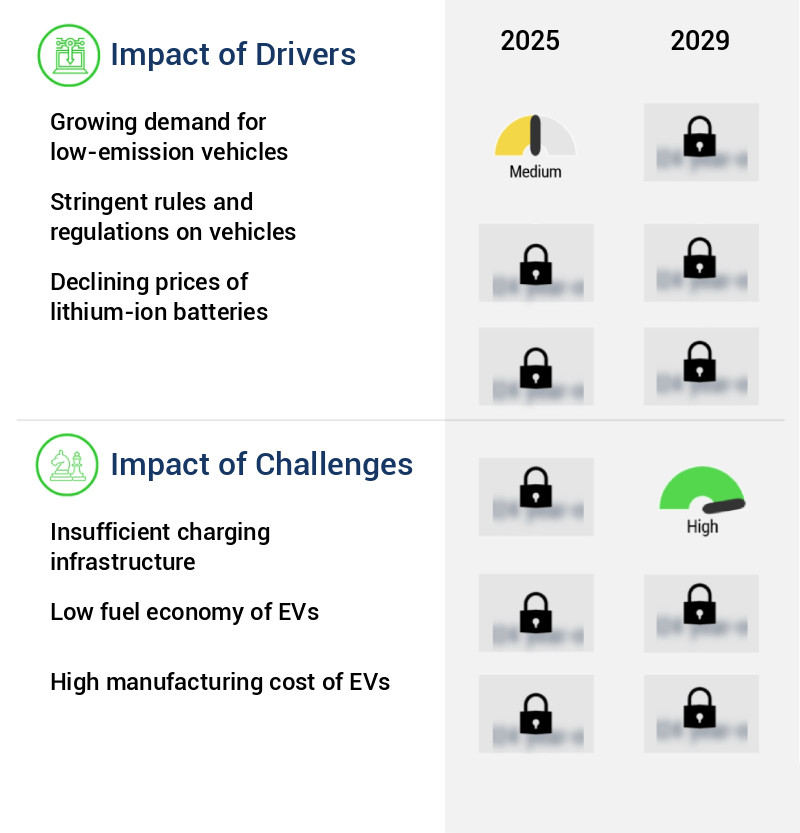
In-Depth Market Segmentation: Electric Vehicle (EV) Market
The electric vehicle (ev) industry research report provides comprehensive data (region-wise segment analysis), with forecasts and estimates in "USD billion" for the period 2025-2029, as well as historical data from 2019-2023 for the following segments.
- Type
- Charging
- Normal charging
- Super charging
- Drive Type
- Geography
- North America
- Europe
- APAC
- China
- India
- Japan
- South Korea
- Rest of World (ROW)
By Type Insights
The bev segment is estimated to witness significant growth during the forecast period.
The market continues to evolve, with battery electric vehicles (BEVs) gaining significant traction among consumers. BEVs, which derive power solely from batteries, have streamlined manufacturing processes compared to plug-in hybrid electric vehicles (PHEVs), as they eliminate the need for internal combustion engines. This simplification results in reduced engineering and capital requirements. Advancements in EV technology include range anxiety mitigation through energy storage systems, electrification conversion kits, and fast charging infrastructure. Improvements in electric vehicle architecture, such as the use of lightweight materials, motor drive inverters, and electric motor efficiency, enhance powertrain efficiency. Solid-state batteries and onboard charger designs offer increased energy density, while battery management systems ensure optimal battery life cycle and thermal runaway prevention.
Moreover, vehicle-to-grid technology, thermal management systems, energy recovery systems, and regenerative braking systems contribute to overall system efficiency. Electric motor torque, battery cell chemistry, and power electronics design play crucial roles in improving vehicle performance. Charging station technology, battery thermal runaway prevention, and autonomous driving systems further strengthen the appeal of BEVs. These advancements underscore the continuous growth and innovation within the EV market.
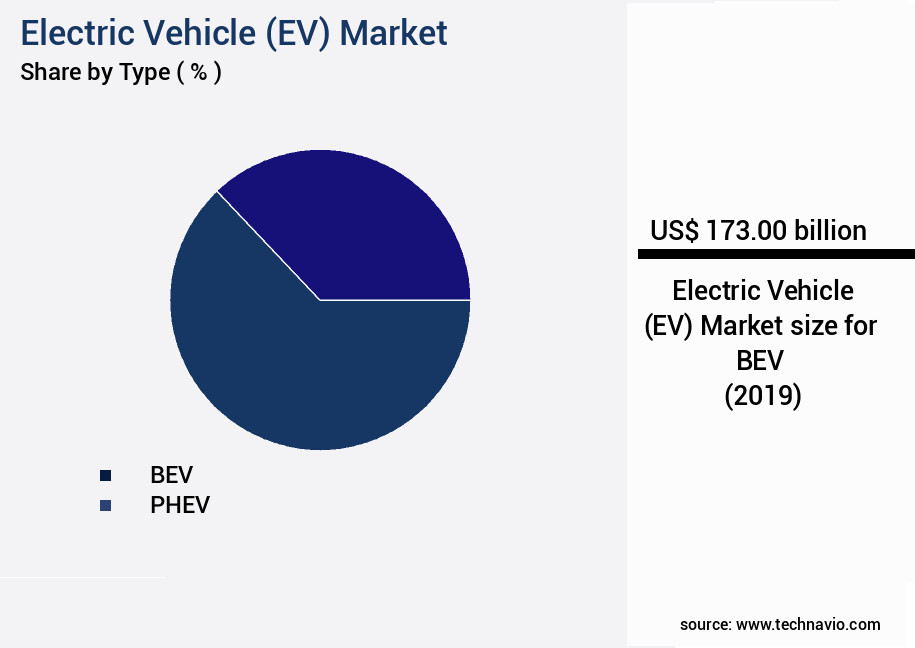
Request Free Sample
The BEV segment was valued at USD 173.00 billion in 2019 and showed a gradual increase during the forecast period.
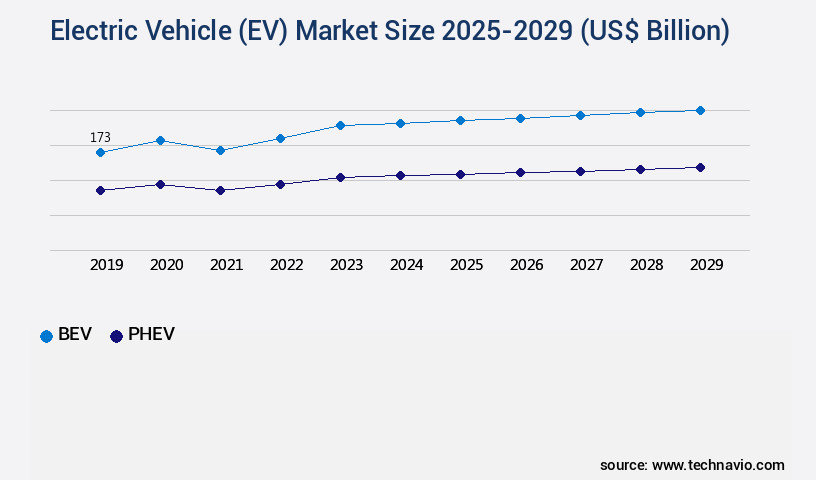
Request Free Sample
Regional Analysis
APAC is estimated to contribute 59% to the growth of the global market during the forecast period.Technavio’s analysts have elaborately explained the regional trends and drivers that shape the market during the forecast period.

See How Electric Vehicle (EV) Market Demand is Rising in APAC Request Free Sample
The market in the Asia Pacific (APAC) region is experiencing significant growth, driven by increasing environmental concerns and stringent emission regulations. With a diverse population and rapid urbanization, APAC is home to both developing and developed economies, each with unique economic, political, and cultural differences. The automotive industry recognizes APAC as the most diverse region in the world, as it is a major producer and consumer of vehicles. Key players in the EV market, such as BYD, Mahindra, and Nissan, are based in the region.
According to recent studies, the EV market in APAC is projected to grow at an impressive rate, with China accounting for over half of the global EV sales in 2020. Additionally, the operational efficiency gains and cost reductions associated with EVs are becoming increasingly attractive to consumers and governments alike, further fueling market growth.
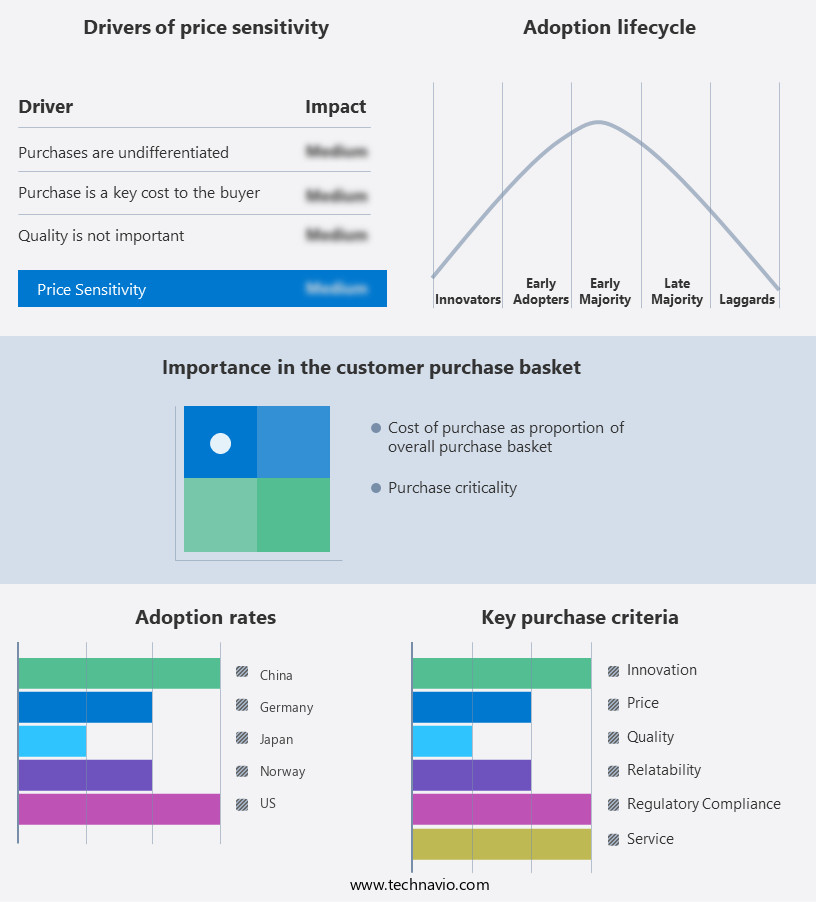
Customer Landscape of Electric Vehicle (EV) Industry
Competitive Intelligence by Technavio Analysis: Leading Players in the Electric Vehicle (EV) Market
Companies are implementing various strategies, such as strategic alliances, electric vehicle (ev) market forecast, partnerships, mergers and acquisitions, geographical expansion, and product/service launches, to enhance their presence in the industry.
Bayerische Motoren Werke AG - BMW's electric vehicle lineup includes the i4 with a maximum range of 307 miles, the i5 offering up to 295 miles, the iX boasting a range of up to 311 miles, and the i7 boasting a range of up to 321 miles. These vehicles demonstrate BMW's commitment to advancing electric technology and expanding electric vehicle options for consumers.
The industry research and growth report includes detailed analyses of the competitive landscape of the market and information about key companies, including:
- Bayerische Motoren Werke AG
- BYD Co. Ltd.
- Chery Automobile Co. Ltd.
- China Dong Feng Motor Industry Imp. and Exp. Co. Ltd.
- Chongqing Changan Automobile Co. Ltd.
- Ford Motor Co.
- Geely Auto Group
- General Motors Co.
- Guangzhou Automobile Group Co. Ltd
- Honda Motor Co. Ltd.
- Hyundai Motor Co.
- Mahindra and Mahindra Ltd.
- Mercedes Benz Group AG
- Nissan Motor Co. Ltd.
- Renault SAS
- SAIC Motor Corp. Ltd.
- Stellantis NV
- Tesla Inc.
- Toyota Motor Corp.
- Volkswagen AG
Qualitative and quantitative analysis of companies has been conducted to help clients understand the wider business environment as well as the strengths and weaknesses of key industry players. Data is qualitatively analyzed to categorize companies as pure play, category-focused, industry-focused, and diversified; it is quantitatively analyzed to categorize companies as dominant, leading, strong, tentative, and weak.
Recent Development and News in Electric Vehicle (EV) Market
- In August 2024, Tesla, the leading electric vehicle (EV) manufacturer, announced the launch of its new Model Y compact SUV in Europe. This expansion marked Tesla's entry into the lucrative European SUV market and aimed to capitalize on the growing demand for electric vehicles in the region (Tesla Press Release, 2024).
- In November 2024, Ford and Volkswagen, two major automotive giants, announced a strategic partnership to develop commercial electric vehicles. This collaboration aimed to pool resources and expertise to accelerate the development and production of electric vans and trucks, targeting the growing demand for zero-emission commercial vehicles (Ford Media Center, 2024).
- In March 2025, CATL, the world's largest battery manufacturer, secured a USD2 billion investment from BlackRock, a leading global investment firm. This significant investment was aimed at expanding CATL's production capacity and further strengthening its position as the leading supplier of batteries for the EV market (Bloomberg, 2025).
- In May 2025, the European Union passed the Fit for 55 package, a comprehensive set of legislative proposals aimed at reducing greenhouse gas emissions by at least 55% by 2030. The package included incentives for electric vehicle adoption, accelerating the transition to zero-emission transportation in Europe (European Commission, 2021).
Dive into Technavio’s robust research methodology, blending expert interviews, extensive data synthesis, and validated models for unparalleled Electric Vehicle (EV) Market insights. See full methodology.
|
Market Scope
|
|
Report Coverage
|
Details
|
|
Page number
|
202
|
|
Base year
|
2024
|
|
Historic period
|
2019-2023 |
|
Forecast period
|
2025-2029
|
|
Growth momentum & CAGR
|
Accelerate at a CAGR of 16.4%
|
|
Market growth 2025-2029
|
USD 446.4 billion
|
|
Market structure
|
Fragmented
|
|
YoY growth 2024-2025(%)
|
13.7
|
|
Key countries
|
China, US, Norway, Japan, Germany, South Korea, India, UK, France, and Canada
|
|
Competitive landscape
|
Leading Companies, Market Positioning of Companies, Competitive Strategies, and Industry Risks
|
Request Free Sample
Why Choose Technavio for Electric Vehicle (EV) Market Insights?
"Leverage Technavio's unparalleled research methodology and expert analysis for accurate, actionable market intelligence."
The market is experiencing significant growth, with lithium-ion batteries being the dominant technology due to their energy density and thermal management capabilities, which are crucial for improving EV range. However, the impact of battery chemistry on performance and the development of high-voltage power electronics for EVs are essential areas of focus to further enhance electric vehicles' capabilities.
Battery life extension strategies, such as optimizing charging patterns and implementing thermal management systems, are vital for ensuring the longevity of EV batteries and reducing the total cost of ownership. Fast charging infrastructure development poses challenges for the EV industry, necessitating advancements in battery technology and charging station compatibility.
Reducing electric motor losses and optimizing regenerative braking efficiency are key areas for EV powertrain design optimization, while solid-state battery technology advancements promise increased energy density and safety. The implementation of wireless charging systems and vehicle-to-grid energy management strategies is also gaining traction, offering potential benefits for both consumers and the grid.
Electric vehicle battery safety concerns, such as thermal runaway and fire risks, must be addressed through rigorous testing and certification processes. Lightweight materials and advanced driver assistance systems integration are essential for improving electric vehicle energy efficiency and enhancing operational planning and supply chain logistics.
The electrification of commercial vehicle fleets represents a significant opportunity for the EV market, with potential cost savings and regulatory compliance benefits. In comparison, the EV market's growth rate is outpacing that of traditional internal combustion engine vehicles by over 20%, underscoring the industry's transformative potential. Designing efficient electric motor controllers and addressing the challenges of autonomous driving capabilities in electric vehicles are also critical areas of focus for industry players.
What are the Key Data Covered in this Electric Vehicle (EV) Market Research and Growth Report?
-
What is the expected growth of the Electric Vehicle (EV) Market between 2025 and 2029?
-
What segmentation does the market report cover?
-
The report is segmented by Type (BEV and PHEV), Charging (Normal charging and Super charging), Geography (APAC, Europe, North America, South America, and Middle East and Africa), and Drive Type (FWD, RWD, AWD, FWD, RWD, and AWD)
-
Which regions are analyzed in the report?
-
APAC, Europe, North America, South America, and Middle East and Africa
-
What are the key growth drivers and market challenges?
-
Who are the major players in the Electric Vehicle (EV) Market?
-
Bayerische Motoren Werke AG, BYD Co. Ltd., Chery Automobile Co. Ltd., China Dong Feng Motor Industry Imp. and Exp. Co. Ltd., Chongqing Changan Automobile Co. Ltd., Ford Motor Co., Geely Auto Group, General Motors Co., Guangzhou Automobile Group Co. Ltd, Honda Motor Co. Ltd., Hyundai Motor Co., Mahindra and Mahindra Ltd., Mercedes Benz Group AG, Nissan Motor Co. Ltd., Renault SAS, SAIC Motor Corp. Ltd., Stellantis NV, Tesla Inc., Toyota Motor Corp., and Volkswagen AG
We can help! Our analysts can customize this electric vehicle (ev) market research report to meet your requirements.
Get in touch
1 Executive Summary
- 1.1 Market overview
- Executive Summary - Chart on Market Overview
- Executive Summary - Data Table on Market Overview
- Executive Summary - Chart on Global Market Characteristics
- Executive Summary - Chart on Market by Geography
- Executive Summary - Chart on Market Segmentation by Type
- Executive Summary - Chart on Market Segmentation by Charging
- Executive Summary - Chart on Incremental Growth
- Executive Summary - Data Table on Incremental Growth
- Executive Summary - Chart on Company Market Positioning
2 Technavio Analysis
- 2.1 Analysis of price sensitivity, lifecycle, customer purchase basket, adoption rates, and purchase criteria
- Analysis of price sensitivity, lifecycle, customer purchase basket, adoption rates, and purchase criteria
- 2.2 Criticality of inputs and Factors of differentiation
- Overview on criticality of inputs and factors of differentiation
- 2.3 Factors of disruption
- Overview on factors of disruption
- 2.4 Impact of drivers and challenges
- Impact of drivers and challenges in 2024 and 2029
3 Market Landscape
- 3.1 Market ecosystem
- Parent Market
- Data Table on - Parent Market
- 3.2 Market characteristics
- Market characteristics analysis
4 Market Sizing
- 4.1 Market definition
- Offerings of companies included in the market definition
- 4.2 Market segment analysis
- 4.4 Market outlook: Forecast for 2024-2029
- Chart on Global - Market size and forecast 2024-2029 ($ billion)
- Data Table on Global - Market size and forecast 2024-2029 ($ billion)
- Chart on Global Market: Year-over-year growth 2024-2029 (%)
- Data Table on Global Market: Year-over-year growth 2024-2029 (%)
5 Historic Market Size
- 5.1 Global Electric Vehicle (EV) Market 2019 - 2023
- Historic Market Size - Data Table on Global Electric Vehicle (EV) Market 2019 - 2023 ($ billion)
- 5.2 Type segment analysis 2019 - 2023
- Historic Market Size - Type Segment 2019 - 2023 ($ billion)
- 5.3 Charging segment analysis 2019 - 2023
- Historic Market Size - Charging Segment 2019 - 2023 ($ billion)
- 5.4 Geography segment analysis 2019 - 2023
- Historic Market Size - Geography Segment 2019 - 2023 ($ billion)
- 5.5 Country segment analysis 2019 - 2023
- Historic Market Size - Country Segment 2019 - 2023 ($ billion)
6 Qualitative Analysis
- 6.1 Impact of AI on the Global Electric Vehicle (EV) Market
7 Five Forces Analysis
- 7.1 Five forces summary
- Five forces analysis - Comparison between 2024 and 2029
- 7.2 Bargaining power of buyers
- Bargaining power of buyers - Impact of key factors 2024 and 2029
- 7.3 Bargaining power of suppliers
- Bargaining power of suppliers - Impact of key factors in 2024 and 2029
- 7.4 Threat of new entrants
- Threat of new entrants - Impact of key factors in 2024 and 2029
- 7.5 Threat of substitutes
- Threat of substitutes - Impact of key factors in 2024 and 2029
- 7.6 Threat of rivalry
- Threat of rivalry - Impact of key factors in 2024 and 2029
- 7.7 Market condition
- Chart on Market condition - Five forces 2024 and 2029
8 Market Segmentation by Type
- 8.1 Market segments
- Chart on Type - Market share (2024-2029) (%)
- Data Table on Type - Market share (2024-2029) (%)
- 8.2 Comparison by Type
- Chart on Comparison by Type
- Data Table on Comparison by Type
- 8.3 BEV - Market size and forecast (2024-2029)
- Chart on BEV - Market size and forecast (2024-2029) ($ billion)
- Data Table on BEV - Market size and forecast (2024-2029) ($ billion)
- Chart on BEV - Year-over-year growth (2024-2029) (%)
- Data Table on BEV - Year-over-year growth (2024-2029) (%)
- 8.4 PHEV - Market size and forecast (2024-2029)
- Chart on PHEV - Market size and forecast (2024-2029) ($ billion)
- Data Table on PHEV - Market size and forecast (2024-2029) ($ billion)
- Chart on PHEV - Year-over-year growth (2024-2029) (%)
- Data Table on PHEV - Year-over-year growth (2024-2029) (%)
- 8.5 Market opportunity by Type
- Market opportunity by Type ($ billion)
- Data Table on Market opportunity by Type ($ billion)
9 Market Segmentation by Charging
- 9.1 Market segments
- Chart on Charging - Market share (2024-2029) (%)
- Data Table on Charging - Market share (2024-2029) (%)
- 9.2 Comparison by Charging
- Chart on Comparison by Charging
- Data Table on Comparison by Charging
- 9.3 Normal charging - Market size and forecast (2024-2029)
- Chart on Normal charging - Market size and forecast (2024-2029) ($ billion)
- Data Table on Normal charging - Market size and forecast (2024-2029) ($ billion)
- Chart on Normal charging - Year-over-year growth (2024-2029) (%)
- Data Table on Normal charging - Year-over-year growth (2024-2029) (%)
- 9.4 Super charging - Market size and forecast (2024-2029)
- Chart on Super charging - Market size and forecast (2024-2029) ($ billion)
- Data Table on Super charging - Market size and forecast (2024-2029) ($ billion)
- Chart on Super charging - Year-over-year growth (2024-2029) (%)
- Data Table on Super charging - Year-over-year growth (2024-2029) (%)
- 9.5 Market opportunity by Charging
- Market opportunity by Charging ($ billion)
- Data Table on Market opportunity by Charging ($ billion)
10 Market Segmentation by Drive Type
- 10.1 Market segments
- Chart on Drive Type - Market share (2024-2029) (%)
- Data Table on Drive Type - Market share (2024-2029) (%)
- 10.2 Comparison by Drive Type
- Chart on Comparison by Drive Type
- Data Table on Comparison by Drive Type
- 10.3 FWD - Market size and forecast (2024-2029)
- Chart on FWD - Market size and forecast (2024-2029) ($ billion)
- Data Table on FWD - Market size and forecast (2024-2029) ($ billion)
- Chart on FWD - Year-over-year growth (2024-2029) (%)
- Data Table on FWD - Year-over-year growth (2024-2029) (%)
- 10.4 RWD - Market size and forecast (2024-2029)
- Chart on RWD - Market size and forecast (2024-2029) ($ billion)
- Data Table on RWD - Market size and forecast (2024-2029) ($ billion)
- Chart on RWD - Year-over-year growth (2024-2029) (%)
- Data Table on RWD - Year-over-year growth (2024-2029) (%)
- 10.5 AWD - Market size and forecast (2024-2029)
- Chart on AWD - Market size and forecast (2024-2029) ($ billion)
- Data Table on AWD - Market size and forecast (2024-2029) ($ billion)
- Chart on AWD - Year-over-year growth (2024-2029) (%)
- Data Table on AWD - Year-over-year growth (2024-2029) (%)
- 10.6 Market opportunity by Drive Type
- Market opportunity by Drive Type ($ billion)
- Data Table on Market opportunity by Drive Type ($ billion)
11 Customer Landscape
- 11.1 Customer landscape overview
- Analysis of price sensitivity, lifecycle, customer purchase basket, adoption rates, and purchase criteria
12 Geographic Landscape
- 12.1 Geographic segmentation
- Chart on Market share by geography 2024-2029 (%)
- Data Table on Market share by geography 2024-2029 (%)
- 12.2 Geographic comparison
- Chart on Geographic comparison
- Data Table on Geographic comparison
- 12.3 APAC - Market size and forecast 2024-2029
- Chart on APAC - Market size and forecast 2024-2029 ($ billion)
- Data Table on APAC - Market size and forecast 2024-2029 ($ billion)
- Chart on APAC - Year-over-year growth 2024-2029 (%)
- Data Table on APAC - Year-over-year growth 2024-2029 (%)
- 12.4 Europe - Market size and forecast 2024-2029
- Chart on Europe - Market size and forecast 2024-2029 ($ billion)
- Data Table on Europe - Market size and forecast 2024-2029 ($ billion)
- Chart on Europe - Year-over-year growth 2024-2029 (%)
- Data Table on Europe - Year-over-year growth 2024-2029 (%)
- 12.5 North America - Market size and forecast 2024-2029
- Chart on North America - Market size and forecast 2024-2029 ($ billion)
- Data Table on North America - Market size and forecast 2024-2029 ($ billion)
- Chart on North America - Year-over-year growth 2024-2029 (%)
- Data Table on North America - Year-over-year growth 2024-2029 (%)
- 12.6 South America - Market size and forecast 2024-2029
- Chart on South America - Market size and forecast 2024-2029 ($ billion)
- Data Table on South America - Market size and forecast 2024-2029 ($ billion)
- Chart on South America - Year-over-year growth 2024-2029 (%)
- Data Table on South America - Year-over-year growth 2024-2029 (%)
- 12.7 Middle East and Africa - Market size and forecast 2024-2029
- Chart on Middle East and Africa - Market size and forecast 2024-2029 ($ billion)
- Data Table on Middle East and Africa - Market size and forecast 2024-2029 ($ billion)
- Chart on Middle East and Africa - Year-over-year growth 2024-2029 (%)
- Data Table on Middle East and Africa - Year-over-year growth 2024-2029 (%)
- 12.8 China - Market size and forecast 2024-2029
- Chart on China - Market size and forecast 2024-2029 ($ billion)
- Data Table on China - Market size and forecast 2024-2029 ($ billion)
- Chart on China - Year-over-year growth 2024-2029 (%)
- Data Table on China - Year-over-year growth 2024-2029 (%)
- 12.9 US - Market size and forecast 2024-2029
- Chart on US - Market size and forecast 2024-2029 ($ billion)
- Data Table on US - Market size and forecast 2024-2029 ($ billion)
- Chart on US - Year-over-year growth 2024-2029 (%)
- Data Table on US - Year-over-year growth 2024-2029 (%)
- 12.10 Norway - Market size and forecast 2024-2029
- Chart on Norway - Market size and forecast 2024-2029 ($ billion)
- Data Table on Norway - Market size and forecast 2024-2029 ($ billion)
- Chart on Norway - Year-over-year growth 2024-2029 (%)
- Data Table on Norway - Year-over-year growth 2024-2029 (%)
- 12.11 Japan - Market size and forecast 2024-2029
- Chart on Japan - Market size and forecast 2024-2029 ($ billion)
- Data Table on Japan - Market size and forecast 2024-2029 ($ billion)
- Chart on Japan - Year-over-year growth 2024-2029 (%)
- Data Table on Japan - Year-over-year growth 2024-2029 (%)
- 12.12 Germany - Market size and forecast 2024-2029
- Chart on Germany - Market size and forecast 2024-2029 ($ billion)
- Data Table on Germany - Market size and forecast 2024-2029 ($ billion)
- Chart on Germany - Year-over-year growth 2024-2029 (%)
- Data Table on Germany - Year-over-year growth 2024-2029 (%)
- 12.13 South Korea - Market size and forecast 2024-2029
- Chart on South Korea - Market size and forecast 2024-2029 ($ billion)
- Data Table on South Korea - Market size and forecast 2024-2029 ($ billion)
- Chart on South Korea - Year-over-year growth 2024-2029 (%)
- Data Table on South Korea - Year-over-year growth 2024-2029 (%)
- 12.14 India - Market size and forecast 2024-2029
- Chart on India - Market size and forecast 2024-2029 ($ billion)
- Data Table on India - Market size and forecast 2024-2029 ($ billion)
- Chart on India - Year-over-year growth 2024-2029 (%)
- Data Table on India - Year-over-year growth 2024-2029 (%)
- 12.15 UK - Market size and forecast 2024-2029
- Chart on UK - Market size and forecast 2024-2029 ($ billion)
- Data Table on UK - Market size and forecast 2024-2029 ($ billion)
- Chart on UK - Year-over-year growth 2024-2029 (%)
- Data Table on UK - Year-over-year growth 2024-2029 (%)
- 12.16 France - Market size and forecast 2024-2029
- Chart on France - Market size and forecast 2024-2029 ($ billion)
- Data Table on France - Market size and forecast 2024-2029 ($ billion)
- Chart on France - Year-over-year growth 2024-2029 (%)
- Data Table on France - Year-over-year growth 2024-2029 (%)
- 12.17 Canada - Market size and forecast 2024-2029
- Chart on Canada - Market size and forecast 2024-2029 ($ billion)
- Data Table on Canada - Market size and forecast 2024-2029 ($ billion)
- Chart on Canada - Year-over-year growth 2024-2029 (%)
- Data Table on Canada - Year-over-year growth 2024-2029 (%)
- 12.18 Market opportunity by geography
- Market opportunity by geography ($ billion)
- Data Tables on Market opportunity by geography ($ billion)
- 12.19 Rest of World (ROW) - Market size and forecast (2024-2029)
- Chart on Rest of World (ROW) - Market size and forecast (2024-2029) ($ billion)
- Data Table on Rest of World (ROW) - Market size and forecast (2024-2029) ($ billion)
- Chart on Rest of World (ROW) - Year-over-year growth (2024-2029) (%)
- Data Table on Rest of World (ROW) - Year-over-year growth (2024-2029) (%)
13 Drivers, Challenges, and Opportunity/Restraints
- 13.3 Impact of drivers and challenges
- Impact of drivers and challenges in 2024 and 2029
- 13.4 Market opportunities/restraints
14 Competitive Landscape
- 14.2 Competitive Landscape
- Overview on criticality of inputs and factors of differentiation
- 14.3 Landscape disruption
- Overview on factors of disruption
- 14.4 Industry risks
- Impact of key risks on business
15 Competitive Analysis
- 15.2 Company ranking index
- 15.3 Market positioning of companies
- Matrix on companies position and classification
- 15.4 Bayerische Motoren Werke AG
- Bayerische Motoren Werke AG - Overview
- Bayerische Motoren Werke AG - Business segments
- Bayerische Motoren Werke AG - Key news
- Bayerische Motoren Werke AG - Key offerings
- Bayerische Motoren Werke AG - Segment focus
- SWOT
- 15.5 BYD Co. Ltd.
- BYD Co. Ltd. - Overview
- BYD Co. Ltd. - Business segments
- BYD Co. Ltd. - Key news
- BYD Co. Ltd. - Key offerings
- BYD Co. Ltd. - Segment focus
- SWOT
- 15.6 Chery Automobile Co. Ltd.
- Chery Automobile Co. Ltd. - Overview
- Chery Automobile Co. Ltd. - Product / Service
- Chery Automobile Co. Ltd. - Key offerings
- SWOT
- 15.7 Ford Motor Co.
- Ford Motor Co. - Overview
- Ford Motor Co. - Business segments
- Ford Motor Co. - Key offerings
- Ford Motor Co. - Segment focus
- SWOT
- 15.8 Geely Auto Group
- Geely Auto Group - Overview
- Geely Auto Group - Product / Service
- Geely Auto Group - Key offerings
- SWOT
- 15.9 General Motors Co.
- General Motors Co. - Overview
- General Motors Co. - Business segments
- General Motors Co. - Key news
- General Motors Co. - Key offerings
- General Motors Co. - Segment focus
- SWOT
- 15.10 Honda Motor Co. Ltd.
- Honda Motor Co. Ltd. - Overview
- Honda Motor Co. Ltd. - Business segments
- Honda Motor Co. Ltd. - Key news
- Honda Motor Co. Ltd. - Key offerings
- Honda Motor Co. Ltd. - Segment focus
- SWOT
- 15.11 Mercedes Benz Group AG
- Mercedes Benz Group AG - Overview
- Mercedes Benz Group AG - Product / Service
- Mercedes Benz Group AG - Key offerings
- SWOT
- 15.12 Nissan Motor Co. Ltd.
- Nissan Motor Co. Ltd. - Overview
- Nissan Motor Co. Ltd. - Business segments
- Nissan Motor Co. Ltd. - Key news
- Nissan Motor Co. Ltd. - Key offerings
- Nissan Motor Co. Ltd. - Segment focus
- SWOT
- 15.13 Renault SAS
- Renault SAS - Overview
- Renault SAS - Product / Service
- Renault SAS - Key news
- Renault SAS - Key offerings
- SWOT
- 15.14 SAIC Motor Corp. Ltd.
- SAIC Motor Corp. Ltd. - Overview
- SAIC Motor Corp. Ltd. - Business segments
- SAIC Motor Corp. Ltd. - Key offerings
- SAIC Motor Corp. Ltd. - Segment focus
- SWOT
- 15.15 Stellantis NV
- Stellantis NV - Overview
- Stellantis NV - Business segments
- Stellantis NV - Key news
- Stellantis NV - Key offerings
- Stellantis NV - Segment focus
- SWOT
- 15.16 Tesla Inc.
- Tesla Inc. - Overview
- Tesla Inc. - Business segments
- Tesla Inc. - Key news
- Tesla Inc. - Key offerings
- Tesla Inc. - Segment focus
- SWOT
- 15.17 Toyota Motor Corp.
- Toyota Motor Corp. - Overview
- Toyota Motor Corp. - Business segments
- Toyota Motor Corp. - Key news
- Toyota Motor Corp. - Key offerings
- Toyota Motor Corp. - Segment focus
- SWOT
- 15.18 Volkswagen AG
- Volkswagen AG - Overview
- Volkswagen AG - Business segments
- Volkswagen AG - Key news
- Volkswagen AG - Key offerings
- Volkswagen AG - Segment focus
- SWOT
16 Appendix
- 16.2 Inclusions and exclusions checklist
- Inclusions checklist
- Exclusions checklist
- 16.3 Currency conversion rates for US$
- Currency conversion rates for US$
- 16.4 Research methodology
- 16.7 Validation techniques employed for market sizing
- Validation techniques employed for market sizing
- 16.9 360 degree market analysis
- 360 degree market analysis
- 16.10 List of abbreviations







![]() Get the report (PDF) sent to your email within minutes.
Get the report (PDF) sent to your email within minutes.
Complimentary full Excel data with your report purchase.